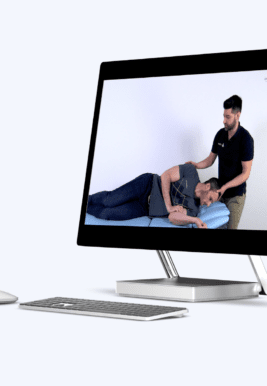Learn
Postural Stability Assessment | Dizziness Assessment
Deficits in postural stability are often noted in patients with traumatic neck pain and cervicogenic dizziness due to abnormal cervical afferent input. This disturbed afferent input impairs the tonic neck reflex to achieve postural stability. Treleaven et al. (2005) conducted the Clinical Test for Sensory Interaction in Balance, abbreviated as CTSIB in patients with traumatic neck pain with dizziness compared to patients with traumatic neck pain without dizziness and healthy controls. They found significantly greater sway and inability to complete the tasks in patients with dizziness.
The following modified sensory organization test can be performed in order to assess for impairments in postural stability. Visual and proprioceptive input from the lower limbs is altered as the tests progress. It is thought that people with neck disorders rely more on vision and other somatosensory inputs for balance and thus deficits will be greatest when these inputs (e.g. vision) are reduced:
- Narrow stance: Have the patient stand barefoot on the floor with the arms across the chest and hands touching his shoulders. The patient‘s feet are together with the ankle bones touching each other. Hold for 30 seconds. As a progression, the test is performed on a foam mat of approximately 10cm thickness with eyes open and then eyes closed
- Tandem stance: Have the patient stand barefoot in a tandem stance, again with the arms crossed on the shoulders and hold for 30 seconds. To progress repeat the test with the eyes closed.
- Single leg stance: Have the patient stand barefoot on one leg, with the other leg flexed and not touching the stance leg. Hold the position for 30 seconds. To progress, repeat the test with your eyes closed.
The tests are positive if the patient is unable to maintain the position for 30 seconds or portrays large increases in sway, slower responses to correct sway or rigidity to prevent sway.
According to the study by Treleaven et al. (2005), it is reasonable to expect that a healthy person under the age of 60 years can maintain stability for up to 30 seconds in the narrow stance tests. Healthy subjects under 45 years should also be able to complete tandem and single-leg stance tests.
LEARN TO TREAT THE MOST COMMON CAUSE OF VERTIGO IN THIS FREE MINI-VIDEO-SERIES

Next to postural balance, your dizziness exam should include the following assessments:
- Gaze stability
- Saccadic Eye Movement
- Eye-Head Coordination
- Joint Position Sense Error
- Smooth Pursuit Neck Torsion Test
- Cervical Torsion Test
- Head-Neck Differentiation Test
Like what you’re learning?
BUY THE FULL PHYSIOTUTORS ASSESSMENT BOOK
- 600+ Pages e-Book
- Interactive Content (Direct Video Demonstration, PubMed articles)
- Statistical Values for all Special Tests from the latest research
- Available in 🇬🇧 🇩🇪 🇫🇷 🇪🇸 🇮🇹 🇵🇹 🇹🇷
- And much more!








